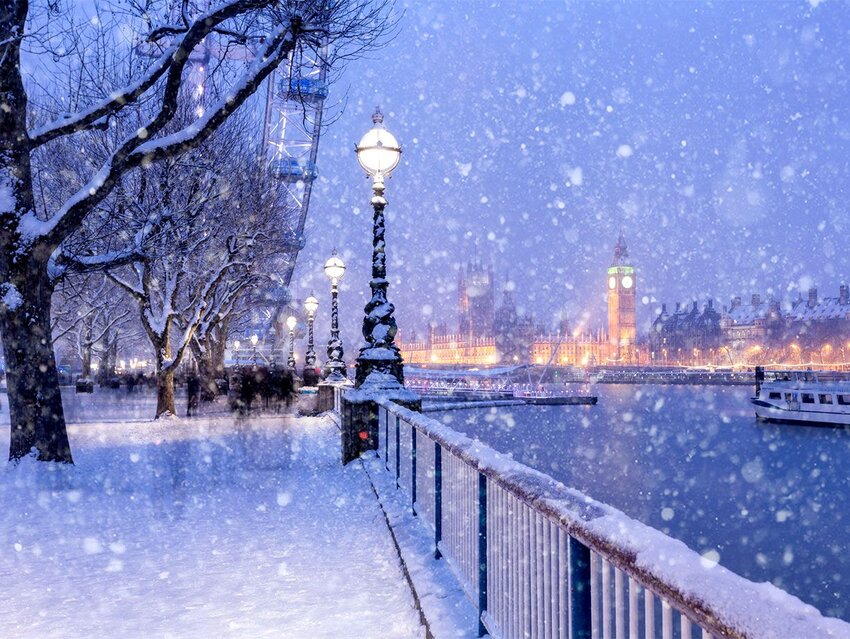Regions across the country experience winter weather very differently. While Texas has a “blue norther,” the Northeast might experience a “bomb cyclone.” The Pacific Northwest has its own slew of weather words, too, from “Alberta clippers” to “chinook winds.” Wherever it’s located, winter weather around the United States has proved to be intense enough to deserve its own jargon.
Alberta Clipper
We’re kicking off by bending the rules — this low-pressure system is named after the western Canadian province of Alberta, but the storms are known to make their way into the U.S. An Alberta clipper is a winter storm that generally moves southward from Alberta into the U.S., by way of the Plains, Midwest, and Great Lakes regions. It’s characterized by light snow, strong winds, and extremely cold temperatures. If the storm forms farther east in Canada, it is sometimes called a “Saskatchewan screamer,” after the province of Saskatchewan.
Blue Norther (Texas Norther)
Blue northers are common occurrences for Texans during wintertime. These cold fronts cause a rapid drop in temperatures across the Southern Plains, often accompanied by precipitation. The name likely stems from the idea that these fronts are followed by a period of blue skies. Texas’ worst blue norther on record happened in 1899 when temperatures dropped to 23 below zero in the panhandle of the state. Some Texans also call this weather event a “blue whistler,” while in Oklahoma, it’s called a “blue darter” or “blue blizzard.”
Bomb Cyclone
This massive low-pressure system brings with it blizzards, severe thunderstorms, and heavy precipitation. For a winter cyclone to become a “bomb,” its central pressure must decrease by at least 24 millibars in 24 hours. This process of rapid intensification is called “bombogenesis,” a term coined in the 1980s that combines “bomb” with “cyclogenesis,” a meteorological term for storm formation. Bomb cyclones are most common along the Eastern Seaboard of the U.S., and cause strong winds, storm surge, coastal flooding, and major snowfall.
Chinook
The Chinookan people are several groups of Indigenous peoples from the Pacific Northwest, and the word “chinook” has been adopted to refer to the people, a type of helicopter, a type of salmon, and a type of winter wind. In the Indigenous language, chinook means “snow eater,” which is exactly what these winds do. A chinook is a warm winter wind that blows down the Rocky Mountains (in the U.S. and stretching up into Canada) onto the eastern slopes and prairies, melting the snow. Usually, chinook winds are welcome because they give locals a break from the cold, harsh winters.
Nor’easter
Nor’easters are powerful storms that impact the Northeastern U.S. during the winter, but can happen anytime from September through April. The name “nor’easter” comes from the fact that the winds from these storms blow in from the northeast. These incredibly strong storms can bring high winds and heavy snowfall — some of the most famous storms in U.S. history have been nor’easters, such as the “Storm of the Century” (also called the “Blizzard of 1993”). As nor’easters intensify along the Atlantic coast, they reach maximum strength in New England and Canada, sometimes causing devastating impacts to major cities, including Boston, Philadelphia, Washington, D.C., and New York City.
Polar Vortex
As its name suggests, a polar vortex is a low-pressure winter system that originates near the North or South Pole. Polar vortexes exist at the poles year-round but strengthen during the winter. Northern areas of the U.S. get to experience a polar vortex when the vortex at the North Pole expands, sending very cold air southward with the jet stream. These cold surges sometimes result in dangerously low temperatures, and can impact vast portions of the country.
Scutch
A scutch is a light dusting of snow, also called a “flurry.” Scutch is used mostly by Delawareans, but this charming term has been used in English to mean “a slight layer or thin coating” or “a sprinkling” since the early 20th century, and likely came from Scotland.
Skiff
“Skiff” is another word for a light snowfall, and it’s used especially in the Midwest. It likely came from the Scottish verb “skiff,” meaning “to lightly move across a surface barely touching it.”
Snow Squall
A snow squall is an intense but usually short period of moderate to intense snowfall, known for low visibility and poor travel conditions. While these types of storms aren’t new, this term wasn’t used in official weather warnings until 2018. Because of their short duration (usually less than 30 minutes), they can also be called a “flash freeze.” Squalls differ from blizzards in that blizzards impact a wider area and usually last longer. The word “squall” came into English in the early 18th century as a nautical term meaning “a sudden, violent gust of wind.”
Featured image credit: _ultraforma_/ iStock

